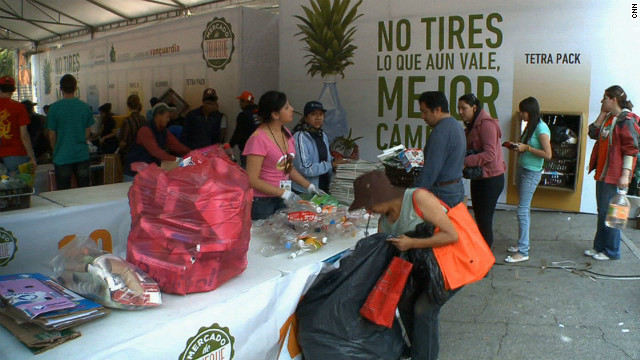The following interview with Josh Talmon is reproduced from a MUZE post dated 8 February 2012.
In Guatemala, a nonprofit is helping communities turn plastic bottles into schools.
It takes a village to raise a child. In some areas of Guatemala, it also takes thousands of plastic bottles. By building schools lined with plastic bottles and inorganic trash, Hug It Forward is addressing two prevalent problems in Guatemala – a lack of safe infrastructure for schools and a growing mountain of trash. The model works like this: Guatemalan children and adults collect the many plastic bottles within their community, stuff them with discarded plastic bags and wrappers, and together they build a school insulated with those very bottles.
With 15 schools completed, 2 in progress, and many waiting to be funded, Hug It Forward is working to spread its Bottle Schools across the globe. Muze recently sat down with three “full-time volunteers” and founders of Hug It Forward – Josh Talmon, Zach Balle, and Heenal Rajani. Together we talked about convincing people that they’re not crazy, their “100% Non-Profit” model, and how they plan to bring a Bottle School to a country near you.
Muze: It seems as if whenever I read articles or watch videos from the press about this project, it’s described as a “crazy idea.” Was there resistance to this project at first? Did people think you were crazy?
Josh Talmon: Yeah, sure, at first it might seem crazy. They might think, wow, these guys are saying that we should collect all this trash – why would we pick all this trash up? Why would we put it in bottles? How the heck is this going to turn into a school? I think when they see an example and when they see that other communities have done it before them, then there’s a lot less skepticism. It helps, too, for people to talk to those other communities and see the school in use and the kids in the classrooms and, hey, look at that, the building made with bottles isn’t falling over!
Muze: You describe your business model as being “The 100% Non-Profit Model.” What does this mean and why do you think it’s so important to highlight this aspect of your organization?
Zach Balle: What that means is that 100% of public donations goes directly towards building Bottle Schools. If you donate $50, every dime will be spent in communities that need a school. This 100% Non-Profit model is sustained thanks to conscious businesses that help cover our overhead. We’ve also started offering one-week “voluntourism” trips through our partner organization, Serve the World Today, which gives anybody the opportunity to come help build a bottle school and discover the rich culture of Guatemala. It costs $1000 to be a “voluntourist,” which covers all their expenses except for flights. Additionally, we also ask these volunteers to raise $500, often through a site called StayClassy, and 100% of that money goes directly towards building Bottle Schools.
So in that way, our model is a little bit different in that we don’t have a traditional fundraising model. Our volunteers are really doing all the work for us – they’re raising the money, they’re coming down here, they’re telling their friends, and that helps us out so much since we don’t have to go and spend big money on big events and fundraisers. We have them, our army of volunteers, raising the money and spreading the word for us!
Josh: Yeah, it’s important to realize that we’re merely facilitators for our volunteers. We just help people have the opportunity to come down here, have an amazing experience, and then go back home and share it with their friends and family.
Muze: How would you describe the communities that you are helping in Guatemala?
Heenal Rajani: Most of them are remote communities in the mountains and volcanoes of Guatemala. We’re working in a lot of underserved areas where they’re gone years without recognition from the government or traditional NGOs.
Josh: We’ve met some really incredible, friendly, and motivated people. The Guatemalans that we work with might not be wealthy, but they’re incredibly rich in culture, in family, in community, and they’ve been so welcoming and appreciative.
Muze: What do you believe is the greatest challenge or obstacle for Hug It Forward?
Zach: Unstable governments. This is the only thing that will stop us from building more Bottle Schools and expanding the program to other countries. Also, natural disasters – hurricanes, mudslides, volcanoes, etc.
“It’s important to realize that we’re merely facilitators for our volunteers.”
Muze: And on the flip side of obstacles and challenges, what do you think is the key ingredient to the program’s continued success?
Zach: I think getting the information out to anyone who can use it is the key ingredient. The idea is to constantly update our Bottle School manual, which teaches people how to build a school, so anyone can use it, whether it’s in India, Southeast Asia, Africa, or South America. It’s not sustainable for us to fly around the world and bring this idea to different places on our own. It’s not about us as people, but what this idea can do to change the world.
Muze: It seems that the goal of the organization is to step aside and really let the people in these communities take control and ownership of this project. Why do you feel that this is important and how successful has this been?
Zach: It’s been extremely successful and I think it’s key for a long term, sustainable program. If we were to just roll in there and build it our way, flip them the keys, and say, ‘Here’s your school!’ then I don’t think it would be as successful. If the people in the community have put in their own blood, sweat, and tears and somebody else comes along and terrorizes the school or vandalizes it, there’s going to be ramifications and that person will be held accountable. They really own this thing. This is their school.
“If you donate $50, every dime will be spent in communities that need a school.”
Muze: You must meet all sorts of amazing and inspiring people while working on this project. Can you share a story of someone you’ve met who has inspired or motivated you?
Josh: There’s Marcos Xe. If you watch the video on our website about the second Bottle School that we built, you’ll see Marcos. He was one of the community members there that really helped out. After the school in his community was built, he reached out and developed a relationship with a nearby community, about 30 minutes away, and invited them to come check out his village’s Bottle School. The visitors were impressed, so Marcos was really encouraging and said, yeah, start collecting your bottles! Let’s start putting inorganic trash into those bottles! Then this other community started clearing land themselves to build their own school. That’s the grassroots and kind of organic feel that we’re going for here. And that just happened on its own, without any of us from Hug It Forward getting involved. Now that this other community is getting established, though, we will be helping them with funding, but what’s really cool is that Marcos and this other community took the initiative on their own. That’s what it’s all about!
Muze: What’s the next step? Where do you see Hug It Forward going in the future?
Josh: For us, our next steps as an organization in 2012 are to really focus on the Bottle School manual. We want to get to the point where someone can just find this document online and do everything themselves to build a bottle school– from empowering the community and collecting bottles and trash to raising funds and construction details. It would also be great to have an online forum where anyone from Peace Corps volunteers to community leaders can answer each other’s questions about how to get these school’s built.
We’re also hoping to expand into other countries. Construction’s already started for a bottle school in El Salvador and we’re hoping to help start a school in Guyana by June.
– Mike Irvine is a researcher and writer at Muze.
– See more at: http://muzes.org/stories/from-trash-to-treasure-plastic-bottle-schools-2/#sthash.ZGtzX0bu.dpuf




 “The objective is that people learn to separate, store and value the
“The objective is that people learn to separate, store and value the 

 Last week, for Greenpeace, 5 women – Victo, Sandra, Sabine, Liesbeth, Wiola and Ali – scaled Europe’s tallest skyscraper:
Last week, for Greenpeace, 5 women – Victo, Sandra, Sabine, Liesbeth, Wiola and Ali – scaled Europe’s tallest skyscraper: